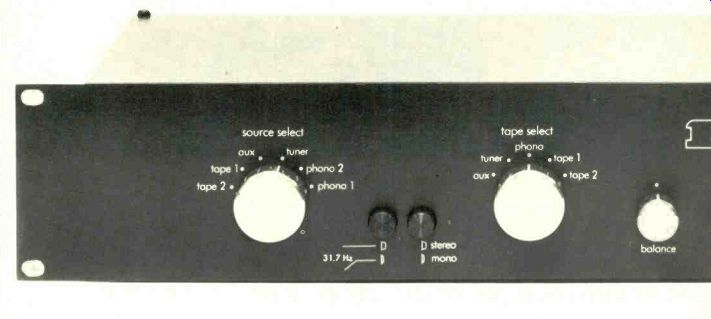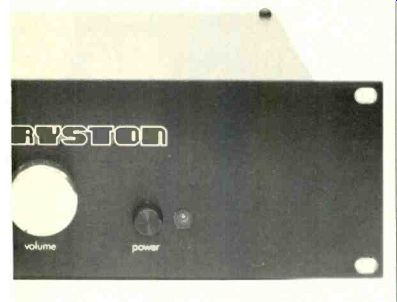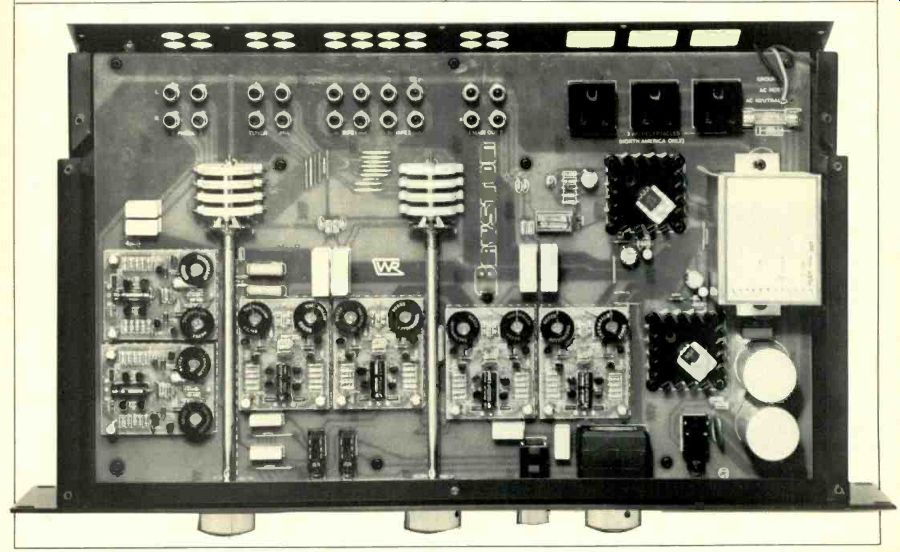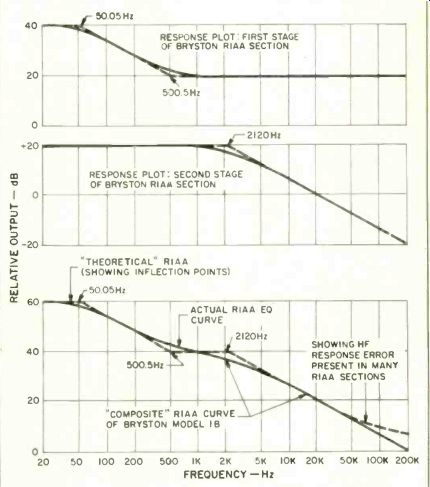
Manufacturer's Specifications
Frequency Response: Phono RIAA and high level, 20 Hz to 20 kHz, ±0.1 dB.
Rated Noise: Phono, -80 dB, A weighted, ref. 5 mV rms at 1 kHz; high level, -95 dB, A weighted, ref. 500 mV at 1 kHz.
Maximum Output: 10 V rms from Tape or main output (typically 20 V rms available). IM or THD Distortion: 0.005 percent.
Price: $700.00.



I must confess that ever since I auditioned and measured Bryston's Model 4B power amplifier a couple of years ago, I have regarded the company with a great deal of respect and admiration. Their 4B amplifier remains a sort of reference product whenever I test or listen to power amps. Having now had an opportunity to examine the Model 1B preamp, it is clear that Christopher Russell (Bryston's chief engineer) and his crew have not lost their touch. This preamp is a fitting companion to any of Bryston's high-quality power amplifiers or to any other high-end state-of-the-art power amplifier with which it might be used.
Front-panel controls on the 1B are kept down to a minimum.
There are, of course, the usual master volume and balance controls, a power on/off switch, and an accompanying power-on indicator light. Two small push buttons serve to activate a low-frequency filter (active below 31.7 Hz with a slope of 6 dB per octave) and to select mono or stereo operation. In addition, separate rotary selector switches are provided for source and tape selection. In other words, you can listen to one program source while you feed another to the tape outputs on the preamp's rear panel. The front panel of the Bryston 1B is designed to fit into standard professional 19-inch rack mounts and is equipped with the necessary mounting holes for such installations.
While it would appear from the above panel description that taping and monitoring facilities are limited, that does not turn out to be the case. Any input except tape 1 or tape 2, when selected, appears at both rear panel tape outputs. The Tape 1 position connects the tape 1 input to the tape 2 output. The Tape 2 position connects the tape 2 input to the tape 1 output, for full two-way dubbing capabilities. Furthermore, when the source selector switch is in the Phono 1 position and the tape selector is in the Phono position, phono 1 inputs are connected to the tape outputs. With the source selector set to any other position, setting the Tape Select switch to Phono connects the phono 2 inputs to the tape outputs. So, if the user wanted to record from a turntable, the phono 2 inputs would be used. The tape monitor function is activated by moving the source selector switch to any input being taped.
Connections to the Bryston 1B preamp are made along a horizontally oriented projecting platform at the rear of the unit.
This arrangement means that no plugs have to project beyond the maximum depth dimension of the component. In addition to the twin pairs of phono inputs, high-level inputs, tape in/out pairs, and two pairs of main output jacks, this connecting "platform" is also equipped with three convenience a.c. receptacles (one unswitched and two switched), each of which is a three-prong, grounded type for minimum hum and maximum electrical safety. A chassis grounding terminal is located near the twin pairs of phono input jacks.
Circuit Highlights
One of the outstanding circuit accomplishments in the Bryston 1B preamp is its phono preamplification and equalization circuitry. As pointed out in their well-written brochure accompanying this unit, the basic problem with most methods of deriving an RIAA equalization response lies in the extreme difference in gain requirements from the lowest to the highest audio frequencies to be reproduced. This calls for the use of reactive components whose a.c. impedance follows the required ratio (about 40 dB of change, or a ratio of 100 to 1), either in a feedback loop or as a direct passive load. If a noninverting feedback network is used in the feedback network, gain cannot be brought below unity. Accordingly, at some high (super-audible) frequency above 20 kHz, the curve would level off instead of continuing to roll off at a rate of 6 dB per octave as specified in the RIAA curve. This brings into play another problem: Due to the combination of severe high-frequency reactive loading and large low-frequency gain, many phono stages have a tendency to oscillate or "motor boat" at some low frequency. Some designers have countered these problems by resorting to completely passive equalization. This in turn can raise new problems, depending upon how the passive equalization is accomplished. Either a sacrifice of signal-to-noise ratio must be made, or the preamplifier must be able to sustain very high gain and excessively high signal levels at high frequencies, increasing the chances of high-frequency overload and distortion.
Bryston chose a third approach in the 1 B. They divided the phono equalization curve into two sections (see Fig. 1). One section accomplishes the low-frequency tailoring, while the other takes care of the high-frequency gain characteristics. The high-frequency section operates in the inverting mode so that the equalization curve remains accurate all the way out to the megahertz region. This inverting configuration also eliminates common-mode distortion, a problem common to amplifiers handling high-frequency signals in a low-gain, noninverting configuration.
Bryston lists as additional advantages of this circuit approach better signal-to-noise ratios, the elimination of phono cartridge interaction without buffer stages, low distortion without the need for extreme amounts of overall feedback, and extremely close accuracy of phono equalization (which they specify at no worse than ±0.1 dB).

Fig. 1--RIAA equalization in the Bryston 1B preamp is accomplished in two separate
stages (upper two graphs) to create composite response shown in lower graph.
Measurements
The true test of a preamplifier such as the Bryston 1B is in the listening, but for the record, I made the usual bench measurements of this superb unit, suspecting all the while that the results would hardly offer any surprises. They didn't. Input sensitivity for both sets of phono inputs (referred to 0.5-volt output at the main output jacks) measured 0.8 millivolt (at 1 kHz). The phono inputs were able to handle signal levels of 1.75 millivolts before noticeable distortion occurred (again, at a frequency of 1 kHz). Hum and noise in phono was impressively low, measuring 83 dB (A weighted) below an input reference level of 5 mV with respect to an output reference level of 0.5 V rms.
Input sensitivity for the high level inputs was 66 millivolts referred to a 0.5-V output. Signal-to-noise ratio for the high level inputs measured 90 dB, improving still further to 94 dB for the minimum volume setting.
Figure 2 is a plot of RIAA phono response (an inverted RIAA test signal is applied to the preamp so that the output curve of response comes out flat if the preamp's E0 is perfect). If you find it difficult to see the response plot, that is because it almost always falls right on the reference grid line (0-dB reference) established for each of the two channels. In Fig. 2A the movable display cursor has been shifted over to 20 Hz (it is obscured by the left-most vertical line of the display) to show a deviation of only 0.1 dB from perfect RIAA in the left channel and 0.0 dB deviation in the right channel. In Fig. 2B the cursor was moved to the right, to 20 kHz (again, it is obscured by the right-most double-vertical line which corresponds to this frequency), and the readout below the graph shows a deviation of only 0.1 dB for the left channel and no deviation at all for the right-channel output.
A repeat plot of phono response for the phono section of the 1B appears in Fig. 3, this time for one channel only and with the low-frequency filter activated. The cursor has been shifted to 25 Hz, where an attenuation of 2.8 dB is recorded by the test equipment. Note that the scale used in this figure is compressed, compared with the scale used in Figs. 2 and 4 (10 dB per vertical division as opposed to 2 dB per division). Figure 4 is a response plot for the high-level inputs of the Bryston 1B and, with the cursor set to its highest possible frequency (40 kHz), an attenuation was recorded of 0.3 dB for the left channel and 0.4 dB for the right channel. In addition to these automatically obtained response plots, I attempted to measure harmonic and intermodulation distortion for the phono and high-level inputs of this preamp. No matter where I measured, the answer always came out 0.002 percent for THD (the known residual THD of the signal generator) and 0.0015 percent for IM (the known residual IM distortion of the SMPTE IM signal source). Duly frustrated by this attempt, I finally made the only meaningful measurement that I could on the bench. Power consumption was 13 watts!

Fig. 2--Phono frequency response error was never more than 0.1 dB for either
channel; deviation shown from RIAA in (A) at 20 Hz and in (B) at 20
kHz.
Fig. 3--Lowcut filter attenuates phono response by 2.8 dB at 25 Hz.
Fig. 4--Highlevel input frequency response was down 0.3 dB in left channel and 0.4 dB in right channel at 40 kHz.
Use and Listening Tests
The Bryston 1B is an audio purist's preamplifier. It adds or subtracts nothing from the program sources fed to it. In almost all of the listening tests, I preferred to leave the low-cut filter on; this was highly effective in reducing too-wide excursions of woofers caused by warpage on some records and by turntable rumble, however minimal it may have been. Phono reproduction was as perfect as I have ever experienced. In a series of A-B tests involving playback of favorite master tapes directly through my current reference power amplifier and through the series combination of the Bryston 1B and that same amplifier (with gain levels carefully adjusted identically), I could detect no difference in sound quality whatever. That's about all anyone can ask of a well-designed preamplifier such as this one. My only regret is that I no longer had the Bryston 4B power amp on hand to team up with this superb preamplifier. Expensive, yes! But for the truly discerning audiophile, that's not likely to make much difference.
-Leonard Feldman
(adapted from Audio magazine, Nov. 1981)
Also see:
Bryston 4B Amplifier (Nov. 1985)
Bryston 4B NRB Amplifier (Equip. Profile, Aug. 1992)
Boulder 500AE Amplifier and Ultimate Preamplifier (Feb. 1990)
= = = =